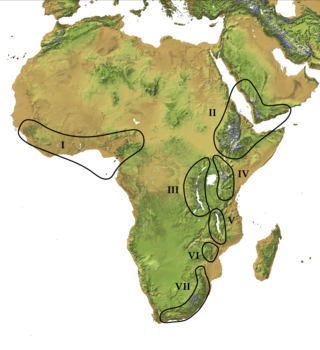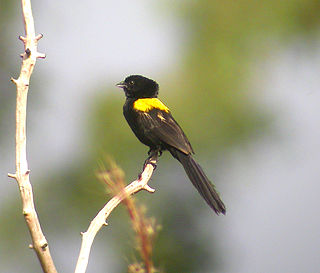
The Sapotaceae are a family of flowering plants belonging to the order Ericales. The family includes about 800 species of evergreen trees and shrubs in around 65 genera. Their distribution is pantropical.

Chrysophyllum is a group of trees in the Sapotaceae described as a genus by Linnaeus in 1753.

Manilkara is a genus of trees in the family Sapotaceae. They are widespread in tropical and semitropical locations, in Africa, Madagascar, Asia, Australia, and Latin America, as well as various islands in the Pacific and in the Caribbean. A close relative is the genus Pouteria.

Pouteria is a genus of flowering trees in the gutta-percha family, Sapotaceae. The genus is widespread throughout the tropical regions of the world. It includes the canistel, the mamey sapote, and the lucuma. Commonly, this genus is known as pouteria trees, or in some cases, eggfruits.

The Afromontane regions are subregions of the Afrotropical realm, one of the Earth's eight biogeographic realms, covering the plant and animal species found in the mountains of Africa and the southern Arabian Peninsula. The Afromontane regions of Africa are discontinuous, separated from each other by lower-lying areas, and are sometimes referred to as the Afromontane archipelago, as their distribution is analogous to a series of sky islands.

The African green pigeon is a species of bird in the family Columbidae, and one of 5 green pigeon species in the Afrotropics. The species has a wide range in Sub-Saharan Africa with around 17 accepted races.

The pale flycatcher is a passerine bird of the Old World flycatcher family Muscicapidae, found in Sub-Saharan Africa.

The yellow-mantled widowbird, also known as the yellow-backed widow, is a species of bird in the family Ploceidae. It is the type species of the genus Euplectes, originally named for the city of Ouidah in Benin. Nowadays the name whydah is however applied to some species in the Viduidae.

The grey tit-flycatcher is a species of bird in the family Muscicapidae. It has an extensive but patchy distribution in sub-Saharan Africa.

The copper sunbird is a species of passerine bird in the family Nectariniidae. It is native to tropical Africa, its range extending from Senegal and Guinea in the west to South Sudan and Kenya in the east, and southwards to Angola, Zambia, Zimbabwe and Mozambique.
Pouteria altissima is a species of plant in the family Sapotaceae, and a source of anigre hardwood. It is found in Burundi, Cameroon, Central African Republic, the Republic of the Congo, the Democratic Republic of the Congo, Ivory Coast, Ethiopia, Gabon, Ghana, Guinea, Kenya, Nigeria, Rwanda, Sierra Leone, Sudan, Tanzania, and Uganda. It is threatened by habitat loss.
Anigre is an African hardwood commonly used for plywood, interior furniture, cabinetry, and high-end millwork applications. It is frequently sliced and sold as veneer, although it is available in board form as well. In board form it is used for boat building, general carpentry, and other light construction uses.
Cuviera is a genus of flowering plants in the family Rubiaceae native to tropical Africa. It was originally described by Augustin Pyramus de Candolle in 1807 and is named after the French naturalist Georges Cuvier.

Cola is a genus of trees native to the tropical forests of Africa, classified in the family Malvaceae, subfamily Sterculioideae. Species in this genus are sometimes referred to as kola tree or kola nut for the caffeine-containing fruit produced by the trees that is often used as a flavoring ingredient in beverages. The genus was thought to be closely related to the South American genus Theobroma, or cocoa, but the latter is now placed in a different subfamily. They are evergreen trees, growing up to 20 m tall, with glossy ovoid leaves up to 30 cm long and star-shaped fruit.
Craterispermum is a genus of flowering plants in the family Rubiaceae. It contains 16 species that occur in tropical Africa and Seychelles. It is the only genus in the tribe Craterispermeae, of which the divergence time is estimated at 34.8 million years ago.

Englerophytum is a group of trees in the family Sapotaceae described as a genus in 1914.
Aningeria adolfi-friederici is a species of plant in the family Sapotaceae, a tall, tropical forest tree. It is found in Burundi, the Democratic Republic of the Congo, Ethiopia, Kenya, Malawi, Rwanda, Sudan, Tanzania, Uganda, Zambia and Zimbabwe. The specific name adolfi-friedericii was given in honour of Duke Adolf Friedrich of Mecklenburg, a German explorer in Africa. Its trade name muna is taken from Gĩkũyũ mũna.

The Victoria Basin forest–grassland mosaic is an ecoregion that lies mostly in Uganda and extends into neighboring countries. The ecoregion is centered north and west of Lake Victoria, with an outlier on the border of Ethiopia and South Sudan.
Donella is a genus of flowering plants belonging to the family Sapotaceae.
Gambeya is a genus of flowering plants belonging to the family Sapotaceae.












